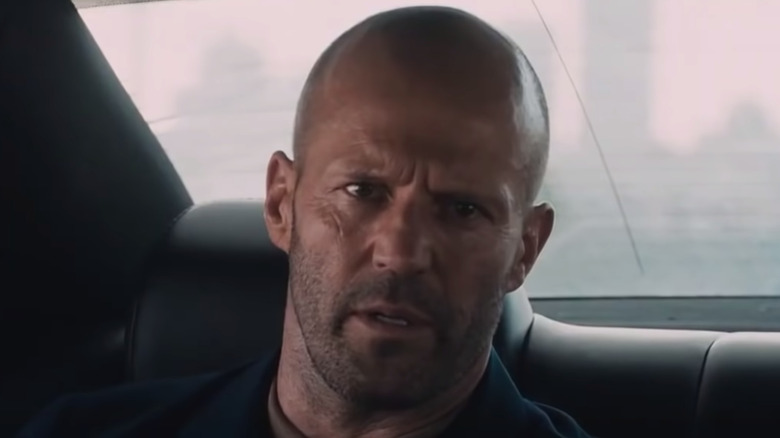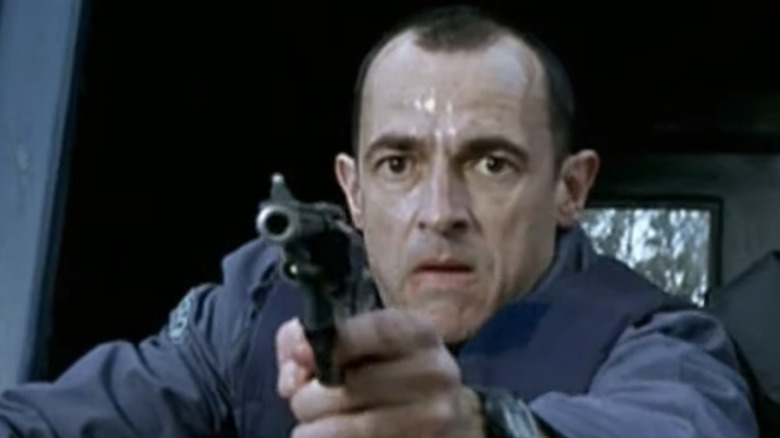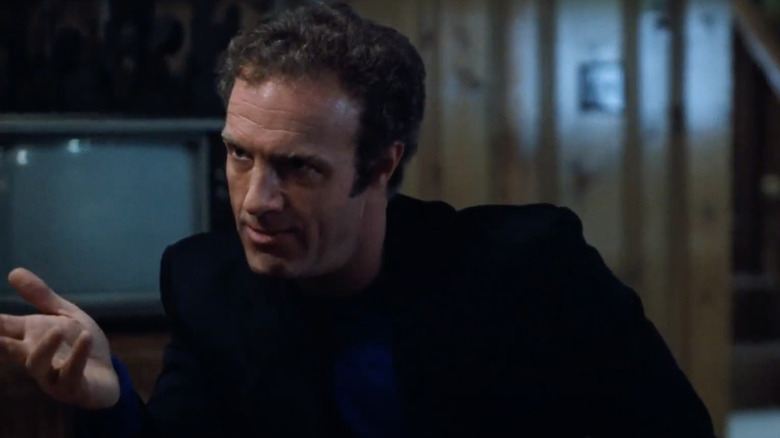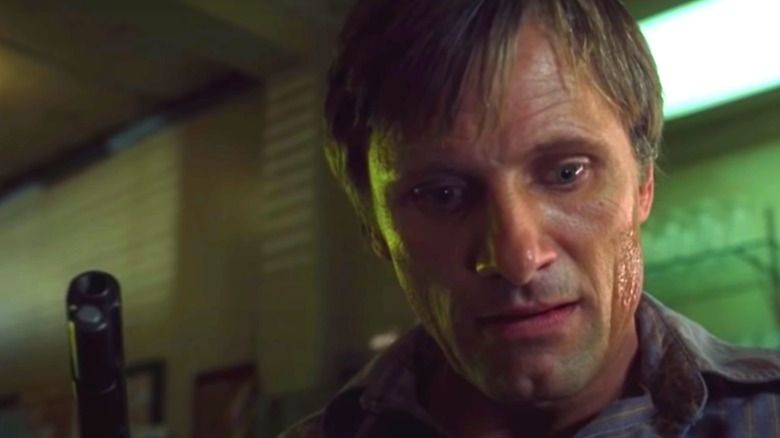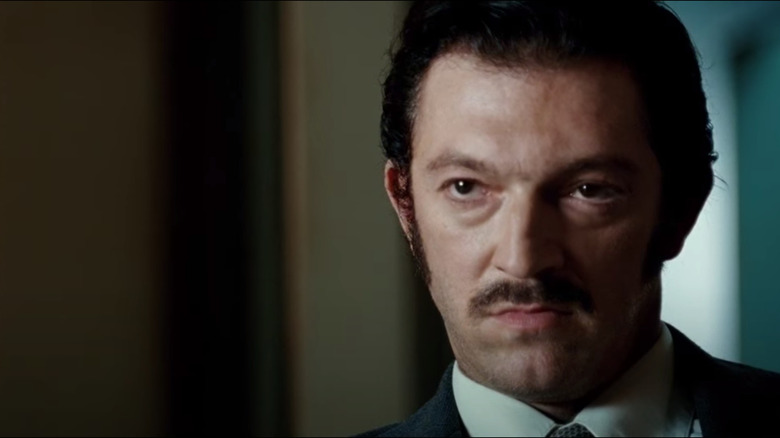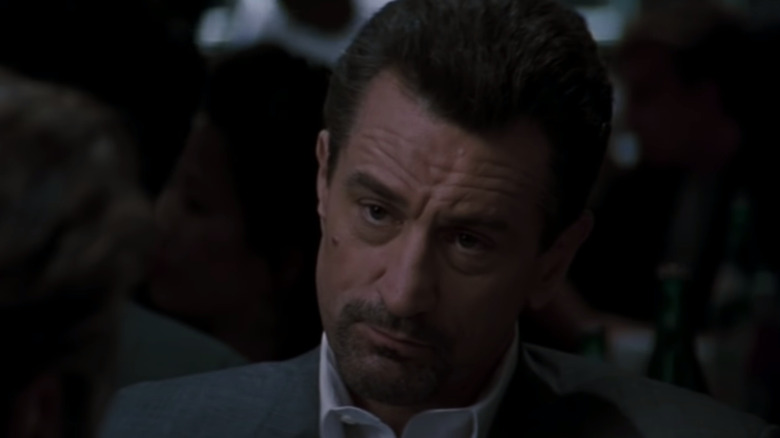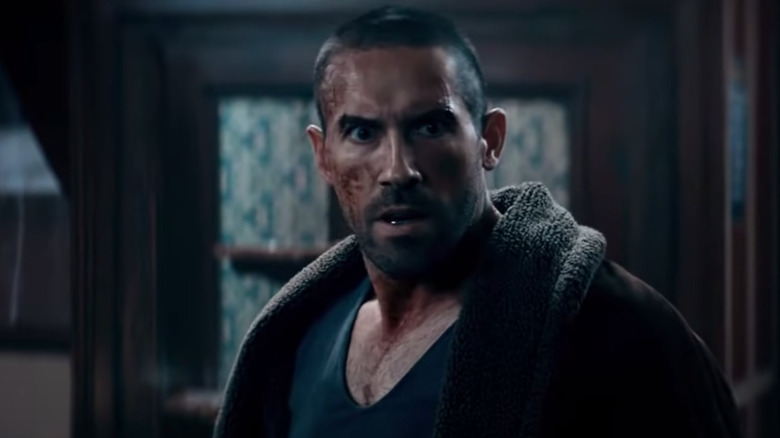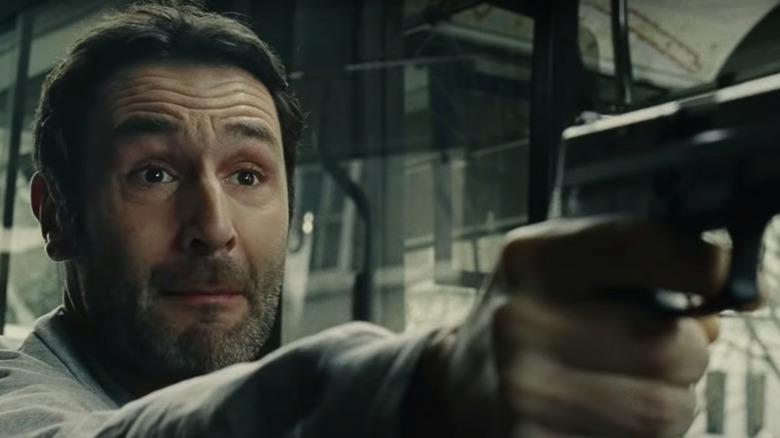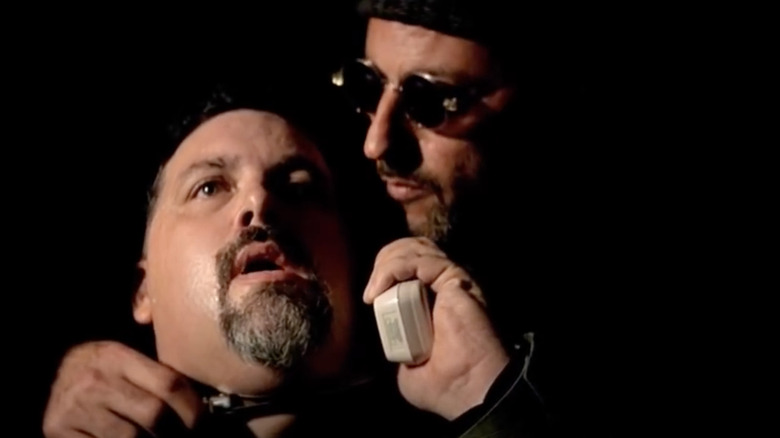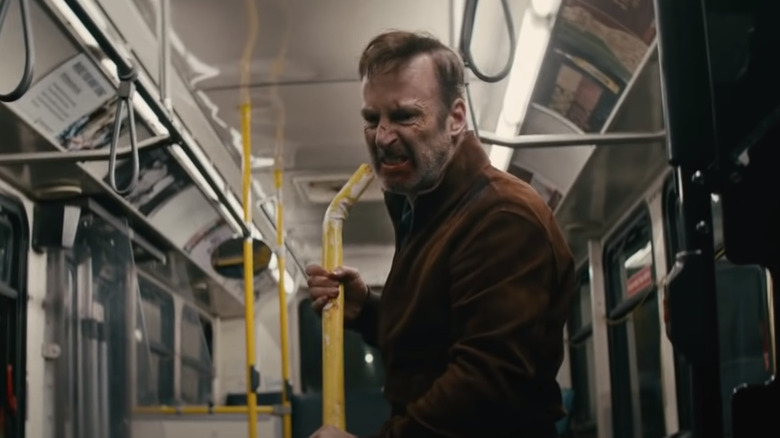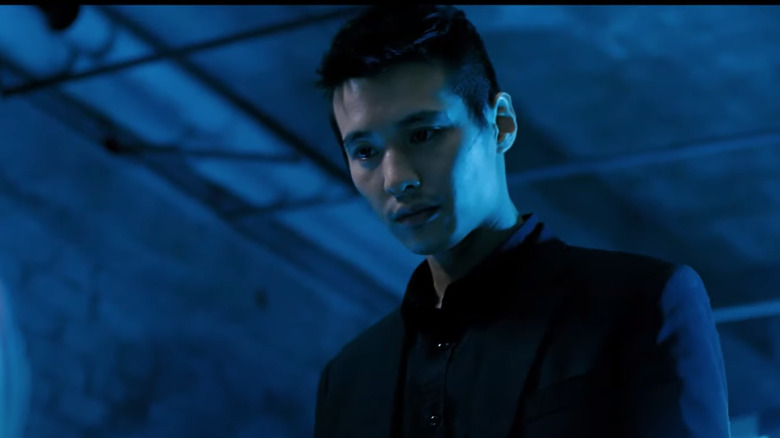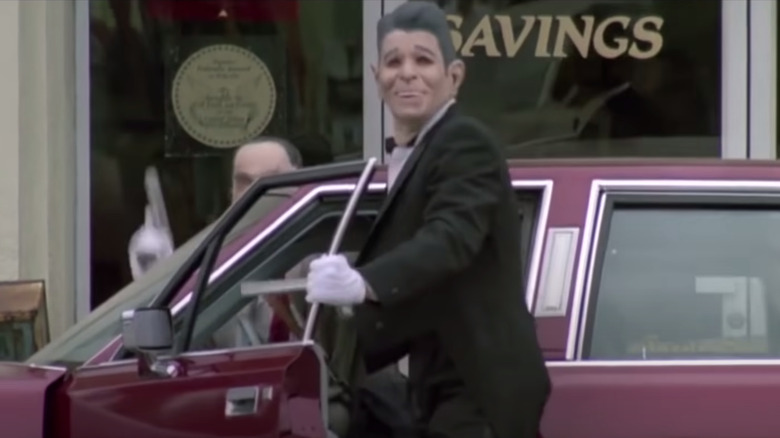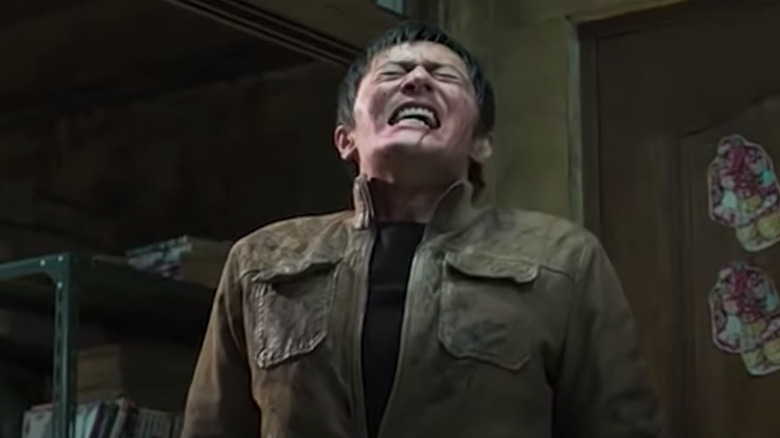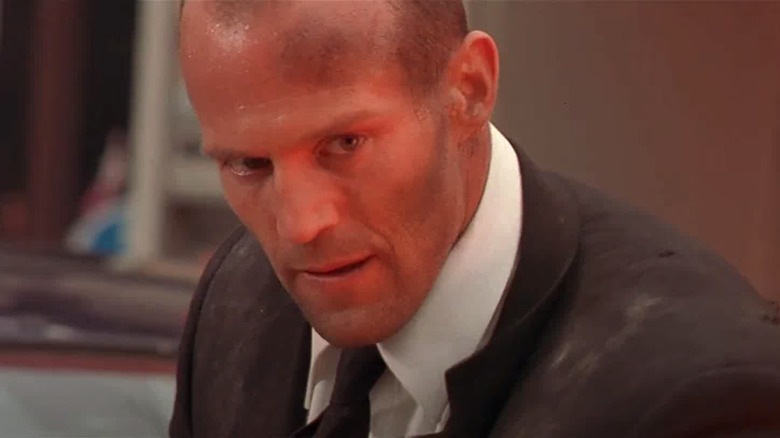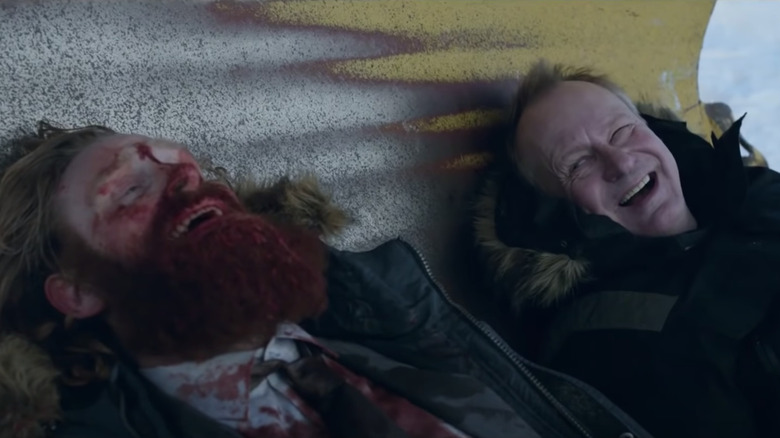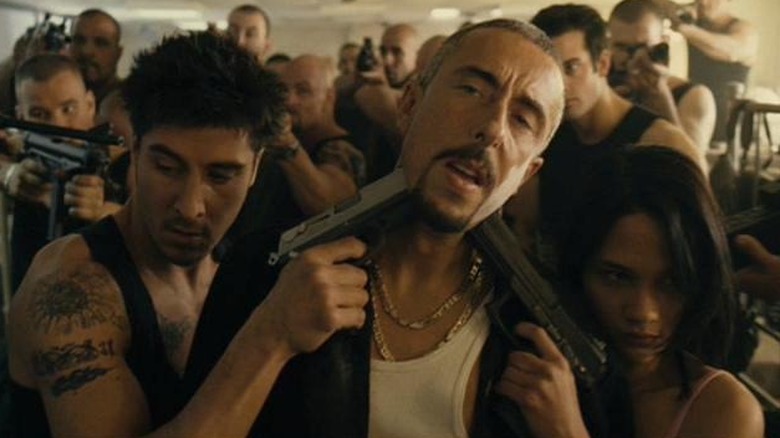15 Movies Like Wrath Of Man That Crime Thriller Fans Need To See
"Wrath of Man" is perhaps Guy Ritchie's most straight-laced when it comes to genre and tone. Ritchie is no stranger to crime-thrillers or action sequences but his previous forays into this territory, like "Revolver," "The Man From U.N.C.L.E.," or the recent "The Gentlemen," have all had healthy doses of humor and style to offset the thrills and violence. That's not to say there is no humor or sense of style to "Wrath of Man" (there's a character named Boy Sweat Dave for crying out loud), but the film certainly plays its cards a little closer to the vest than Ritchie is known for doing. Though the plot of "Wrath of Man" might be told non-chronologically, it is in other ways more straightforward than much of Ritchie's filmography.
"Wrath of Man" marks the first collaboration between Guy Ritchie and star Jason Statham since 2005's "Revolver." Ritchie and Statham got their starts together with "Lock, Stock and Two Smoking Barrels," which they quickly followed up with "Snatch." This pair of grade-A British gangster-comedies propelled both men into the international spotlight and kicked off what would become long and highly-profitable careers. Though "Lock, Stock" and "Snatch" both contain brief flashes of violence, Statham was far from the action hero he is known as today.
If you're looking for more tough crime-thrillers with hefty doses of action, look no further than this assortment of similar films from around the world.
Le Convoyeur
"Wrath of Man" is actually a remake of a French crime-thriller from 2004. The original title of the film, "Le Convoyeur," translates directly as "The Conveyer," but the film is also known as "Cash Truck" in English. If you enjoyed "Wrath of Man," it might be worth checking out the original telling of this tale as directed by Nicolas Boukhrief. The two films share the same framework and general plot but are drastically different in execution.
Albert Dupontel fills the protagonist role and offers a much different take on the part than Statham's cold brooding, and Jean Dujardin has a great supporting role a few years ahead of his Oscar win in 2012 for "The Artist." Ritchie's adapted screenplay for "Wrath of Man" changes up and complicates the story of the 2004 original. "Le Convoyeur" tells a less complex story but increases the emotional resonance in its shorter runtime by focusing more on the father-son relationship that motivates the protagonist's need for revenge.
"Le Convoyeur" is more colorful, more tonally varied, and features a more dynamic shooting style — though it lacks the layer of big-budget gloss, the flashy supporting cast, and the modern special effects of "Wrath of Man." Both films are worth watching and they have different strengths.
Thief
Michael Mann's first feature film (not counting the made-for-TV movie "The Jericho Mile") immediately established his consummate grasp of stylish crime-thrillers. "Thief" is a 1981 neo-noir flavored heist film with a healthy dose of Mann's trademark gunplay. The story follows the top safecracker in Chicago's criminal underworld who attempts a final score before going straight. If you enjoyed the heist elements of "Wrath of Man," then "Thief" should satisfy your need for more like it and then some.
"Thief" is grounded with a strong sense of realism and features a deceptively complex lead character played by James Caan. This sense of realism comes in part from the film's adapted source material, a non-fiction book titled "The Home Invaders: Confessions of a Cat Burglar." Michael Mann's loose adaptation of the book wasn't a smash-hit at the time of release, but the critical response has turned overwhelmingly in the movie's favor over the years.
James Caan is at the top of his game in the lead role. In an interview for the Criterion Collection release of the film, Caan called his role in "Thief" one of the performances he is most proud of.
A History of Violence
In "Wrath of Man," Jason Statham's lead character, nicknamed H, is a mysterious fellow for much of the film's first act. It's clear he's holding back his abilities and his true motives as he moves through the training for his new job as cash-truck security, and our suspicions are confirmed by the time the first shootout breaks out. With an entire chapter of the film spent in flashback, the backstory and motivations of the once mysterious H are fully fleshed out.
A crime-thriller that plays with identity in a similar way is 2005's "A History of Violence," based on the graphic novel of the same name. Viggo Mortensen plays Tom Stall, a small-town diner owner who is not what he seems. Beneath his exterior as an all-American family man lies the suppressed identity of a violent gangster. "A History of Violence" might feature less action than "Wrath of Man," but whenever violence does enter the picture, it always hits hard.
"A History of Violence" was a bit of a departure for director David Cronenberg, who built his career primarily as a horror filmmaker with the likes of "The Fly," "Dead Ringers," and "Videodrome" serving as highlights of his filmography. Though "A History of Violence" is far from being a horror film, Cronenberg brought along his flair for body-horror, turning all of the deaths in this crime-thriller into extraordinarily gory affairs.
Mesrine: Killer Instinct & Public Enemy No. 1
"Mesrine: Killer Instinct" along with its sequel "Mesrine: Public Enemy No. 1" have much in common with "Wrath of Man." The "Mesrine" films and "Wrath of Man" are violent crime-thrillers with flashy action sequences and heist elements. The two "Mesrine" films were shot back-to-back with a one-month hiatus between productions and both hit theaters in the last quarter of 2008. The second film was actually shot first, owing to the substantial change in weight undergone by the lead character as played by the excellent Vincent Cassel.
The "Mesrine" films tell the story of Jacques Mesrine, a violent French gangster who became public enemy number one in the 1970s. "Mesrine: Killer Instinct" tells the story of Jacques Mesrine's first experiences with crime, killing, bank robbery, and prison breaking as he rises in infamy, while "Public Enemy No. 1" tracks his fall and eventual demise. "Killer Instinct" has the more compelling structure, but both films are tight and engaging and both received much love and acclaim at France's César Awards.
Vincent Cassel is magnetic as the titular Jacques Mesrine and carries himself equally well in and out of action sequences. But Cassel isn't the only firecracker on the cast. The supporting cast is equally strong with the likes of Gérard Depardieu playing opposite Cassel in the first installment and the inimitable Mathieu Amalric in the second. The "Mesrine" films make for a great double feature if you have a hefty four hours free.
Heat
Michael Mann rears his head again, this time with the crown-jewel of his filmography: "Heat." It isn't hard to see why "Heat" is often one of the best heist films of all time. "Heat" even has perhaps the definitive armored-truck robbery scene, a scenario integral to the plot of "Wrath of Man."
Though they had both starred in "The Godfather: Part II," Al Pacino and Robert De Niro never shared a scene together. The first time these two movie titans acted opposite each other on the silver screen was in "Heat," and Michael Mann provided them with material worthy of such a landmark thespian crossover. Both actors are given their time to shine in this cops-and-robbers crime saga. With the likes of Val Kilmer, Jon Voight, Wes Studi, Tom Noonan, Ashley Judd, William Fichtner, Natalie Portman, Mykelti Williamson, and more rounding out the supporting cast, every performance in "Heat" is impeccable, no matter how small the part.
The centerpiece shootout following the bank robbery stands tall as one of cinema's all-time great shootouts. Mann executed the scene with an uncompromising sense of realism that sets it apart from the vast majority of movie gunfights. Michael Mann put his cast through extensive live-fire target practice and specialized training, ensuring that their performances and movements during the scene were 100% authentic. The choice to use the real location audio of thunderous blanks echoing down the street rather than typical movie SFX was the perfect icing on the cake of a masterpiece shootout.
Avengement
"Wrath of Man" might be set in Los Angeles, but — with a British director and star, a supporting cast filled with UK actors doing American accents, and even a significant portion of the film being shot in London, England – it feels distinctly English. "Avengement" is a homegrown British action flick that opts for martial arts style fight scenes over shootouts and gets great mileage out of a clever flashback narrative that allows the film to be a chamber drama, a crime thriller, and a prison film all at once.
Director and co-writer Jesse V. Johnson has thoroughly established himself as one of the best low-budget action filmmakers in the game. He has directed more than 20 films since 1999 and kept up a busy career as a stunt double and stunt coordinator as well. While his movies often go straight to DVD or streaming and don't receive too much mainstream attention, they frequently contain better action sequences than many major studio releases, and 2019's "Avengement" shines as arguably his finest work yet, marrying a compelling script and lead character with his exceptional flair for martial-arts mayhem.
The incredibly athletic and often underutilized Scott Adkins has collaborated with Jesse V. Johnson on several films such as "Savage Dog," "Triple Threat," "Accident Man," and the "Debt Collector" films. "Avengement" provides Adkins with one of his best roles, allowing him to show off his acting abilities alongside his impressive physical prowess. The action scenes are excellent all throughout, but the big action showstopper is rightfully saved for the end of the film, which should join the ranks of the best movie bar fights of all time.
Point Blank
This French crime-thriller from 2010 takes the familiar premise of an ordinary man attempting to save his wife from violent gangsters and changes up the formula just enough to keep it fresh. Just like "Wrath of Man," "Point Blank" doesn't reinvent the wheel, nor does it attempt to. Where "Point Blank" excels is in its commitment to the genre and its slick action scenes. The catalyst for the bloodshed in "Point Blank" is when Gilles Lellouche's main character, who works as a nurse, unwittingly saves the life of a dangerous criminal. It's an interesting spin on genre conventions that the act of saving a life is what leads to other lives being taken.
The film's short runtime pulses along with plenty of tension and keeps the familiar plot from outstaying its welcome. Roschdy Zem stands out with his intense performance as the rescued gangster. "Point Blank" was subsequently remade in 2019 as a Netflix original starring Frank Grillo and Anthony Mackie. While the English-language remake wasn't too well received by critics or audiences, the French-language original fared much better with critics and audiences alike and makes for a fun, breezy watch.
Léon: The Professional
Luc Besson's classic hitman crime film delivers electrifying action with a heavy emotional grounding in the relationship between the titular hitman Léon, played by the excellent Jean Reno, and the freshly orphaned Mathilda, played by a young Natalie Portman in her first ever film role. Perhaps outshining them both is Gary Oldman delivering an absolutely unhinged performance as the film's over-the-top villain Stansfield, the corrupt cop responsible for the death of Mathilda's family. Children in peril, double-crosses, and corrupt authority figures are all commonalities between "Leon" and "Wrath of Man."
"Léon: The Professional"— also known as just "Léon" or just "The Professional" depending on the country distributing it — is one of the highest rated films on the Internet Movie Database and landed on Empire Magazine's prestigious list of the best action films of all time. Luc Besson has directed a number of enduring action films, like "Nikita" and "The Fifth Element", and he has written even more, having had a hand in the creation of the "Taken," "District B13," and the "Transporter" series.
Nobody
"Wrath of Man" and "Nobody" are both action-filled crime-thrillers from 2021 that follow protagonists who hide both their identities and their destructive abilities. Jason Statham's screen persona as an action hero telegraphs his kick-ass potential from the beginning of "Wrath of Man." Meanwhile, Bob Odenkirk's badass turn in "Nobody" comes as a genuine surprise, given that he's spent the majority of his career as a writer and comedic actor. Odenkirk's training regimen and physical transformation for the role would be extremely impressive coming from anyone, but are especially staggering coming from someone his age and after the career he had led thus far.
After failing to stop a home invasion, a seemingly ordinary man reawakens his long-dormant skillset as an "auditor" and winds up at odds with a volatile crime boss. "Nobody" is put together by the same team behind "John Wick" — the script is from "John Wick" screenwriter Derek Kolstad and action sequences crafted by 87eleven Action Design. Director Ilya Naishuller might not be a household name quite yet, but after directing a couple of action-packed music videos for his band Biting Elbows and writing/directing the severely underrated first-person action film "Hardcore Henry," he's proven himself to be a name worth watching. But, if there's a single reason to watch "Nobody," it's to see Bob Odenkirk like you've never seen him before.
The Man From Nowhere
"The Man From Nowhere" is another crime thriller that plays with the mysterious identity of its lead character, just like "Wrath of Man." Both H in "Wrath of Man" and Cha Tae-sik in "The Man From Nowhere" are clearly far more dangerous and have much more troubled pasts than they like to let on, and both films deliver large bursts of action in the right spots. Comparing action to action, "The Man From Nowhere" comes out leagues ahead of Guy Ritchie's latest film. There is plenty of excellent gunplay throughout the film, but keep an eye out for the climactic action sequence in particular which transitions seamlessly from a top notch shootout into one of the best knife fights ever recorded.
This South Korean film from writer-director Lee Jeong-beom became the country's highest grossing movie of 2010 and was considered by the LA Times to have significantly "boosted South Korea's film industry." An American remake is currently in the works with Derek Kolstad writing and Chad Stahelski producing, both of whom launched the "John Wick" franchise (via Deadline). The story of "The Man From Nowhere" is rather familiar (in fact, it's quite similar to the aforementioned "Léon: The Professional"), but the slick presentation and jaw-dropping action sequences are enough to set this South Korean take on the story apart from similar fare.
Point Break
The original "Point Break" from 1991 has robbery elements in common with "Wrath of Man," and both films share undercover protagonists — though the morality of H and Johnny Utah certainly doesn't align. Though both are crime-thrillers with plenty of action, the two are quite different when it comes to tone. While "Wrath of Man" is serious and dour, "Point Break" is fun and cheesy in an enjoyable way with a somewhat far-fetched story about an FBI agent going undercover to take down a gang of surfing, adrenaline junkie bank robbers.
The chemistry between Keanu Reeves's undercover FBI agent Johnny Utah and Patrick Swayze's surfing bank robber Bodhi is one of the film's major strengths. In many ways, "Point Break" plays out like a love story between the two of them on opposite sides of the law, which makes their shared love interest played by Lori Petty feel like an unnecessary third wheel.
"Point Break" was the first film Kathryn Bigelow directed without also having a hand in the writing of the screenplay. The action throughout is extremely varied with a mix of shootouts, fist fights, car chases, foot chases, and, of course, an emphasis on adrenaline with the likes of the unforgettable sky-diving sequence.
No Tears for the Dead
"No Tears for the Dead" is another excellent South Korean crime-thriller from writer-director Lee Jeong-beom. Just like "Wrath of Man," opposing parties of criminals clash after a young, innocent life is lost in an avoidable accident. Also just like Lee Jeong-beom's previous film, "The Man From Nowhere," "No Tears for the Dead" tells a decidedly familiar story — this time the story of a hitman falling in love with someone he's supposed to kill while racked with guilt about killing someone he wasn't supposed to — but tells it exceedingly well.
Jang Dong-gun is incredibly badass in the lead role and is a huge part of why the film works as well as it does. Fans of South Korean cinema may be familiar with Jang Dong-gun from his starring roles in Kang Je-kyu's excellent war films "My Way" and "Tae Guk Gi: The Brotherhood of War." Though Jang Dong-gun was no stranger to performing action scenes on film, he underwent extensive combat training for his role in "No Tears for the Dead," and the results on screen speak for themselves.
With a veritable rogues gallery of well-characterized villains for Jang Dong-gun to square off against with guns, knives, and bloody knuckles, the action in "No Tears for the Dead" all feels substantial and hits hard. The standout scene is the extended action set piece in the middle of the film where shooters are spread out across the rooftops of three high-rise buildings, all converging in the middle with unarmed civilians caught in the crossfire.
The Transporter
If star Jason Statham is your favorite part of "Wrath of Man," then you're in luck, as he has plenty of other action-packed crime films to explore. Sorting through the duds can be a bit of chore, however, as not all of the films in Jason Statham's filmography are created equally. Films like "Parker" and "Blitz" fall a little flat beside the likes of "Crank" and "The Transporter."
While Statham had performed a little bit of action on screen before in supporting roles in the likes of "The One" and "Ghosts of Mars," it was "The Transporter" in 2002 that rocketed him to action star status. "The Transporter" was a surprise hit, leading to two direct sequels starring Statham and a prequel/reboot in 2015 titled "The Transporter: Refueled" (in which Statham's role was recast after he turned down the project due to script and salary concerns). There was even a "The Transporter" TV series that ran for two seasons with Chris Vance in Statham's role. The premise of a placid driver expertly transporting deliveries for dangerous people certainly has the potential for multiple stories.
The tone of the "Transporter" films is much lighter than that of "Wrath of Man," and the series continued to get cheesier as it moved along. They might not knock your socks all the way off, but the first two "Transporter" films are a fun time if you're in the mood for more Statham ass-kicking, though you might want to skip the third film and the reboot.
In Order of Disappearance
"In Order of Disappearance" is a Norwegian crime-thriller with a pitch-black sense of humor. Similar to "Wrath of Man," both films follow a man who decides to seek revenge after his son is killed by a group of criminals. The two films also share some presentational elements, such as interspersing the film with text over black at key moments, and have similar pacing throughout before culminating in a big shootout climax.
The original Norwegian title of the film, "Kraftidioten," translates directly as "The Power Idiot," but the title was changed to "Cold Pursuit" when director Hans Petter Moland decided to remake his own film for English-speaking audiences in 2019. Big fans of Liam Neeson can check out the 2019 remake, but the original "In Order of Disappearance" from 2014 has the leg up when it comes to the execution in most regards, and Stellan Skarsgård is excellent in the lead role.
The complex tone of "In Order of Disappearance" may put some viewers off, and it's exceptionally dark sense of humor will not gel with everyone, but it's impossible to deny that the film feels distinct amidst other entries in the crime-thriller genre. Death is handled with more weight than the average genre fare, and much of the violence is implied or left offscreen until the big gunfight climax. If you're looking for something on similar territory as other crime-thrillers but that feels decidedly different, give "In Order of Disappearance" a shot.
Banlieue 13
This action-packed crime film from France has a knack for feeling small and scrappy, yet big and bombastic at the same time. With a script co-written by Luc Besson, "Banlieue 13," also known as "District B13," features a clever premise and an extremely light sci-fi setting. The film is set in 2010, just six years into the future from its release in 2004. In addition to being on similar genre footing, "Banlieue 13" and "Wrath of Man" both focus to a degree on gang violence and feature undercover protagonists executing dangerous missions. In "Banlieue 13," an elite undercover cop infiltrates a walled-off district overrun with crime and is forced to work with a local to stop a drug kingpin threatening to wipe out the entire district with a bomb.
"Banlieue 13" was the first film from director Pierre Morel, who would go on to launch the massively successful "Taken" franchise with his very next film, which also made use of a script co-written by Luc Besson. "Banlieue 13" also spawned a sequel, "District B13: Ultimatum," which Luc Besson returned to write. "Banlieue 13" was later remade as "Brick Mansions" in 2014, though the less said about that film, the better.
Rather than the focus on gunplay seen in "Wrath of Man," "Banlieue 13" focuses primarily on action carried out by the human body alone. Though the first movie to feature parkour was "Yamakasi" from a couple of a years earlier (also written by Luc Besson), "Banlieue 13" is still noteworthy for being one of the first major films to utilize the movement sport of parkour on screen. One of the film's two leads is played by David Belle who is considered one of the founders of parkour, and his athleticism in "Banlieue 13" is an incredible sight to behold. Two years later, "Casino Royale" made use of Sébastien Foucan for the opening chase sequence and rocketed the sport to international attention. Foucan co-founded parkour alongside Belle and later established freerunning as an offshoot of parkour.
